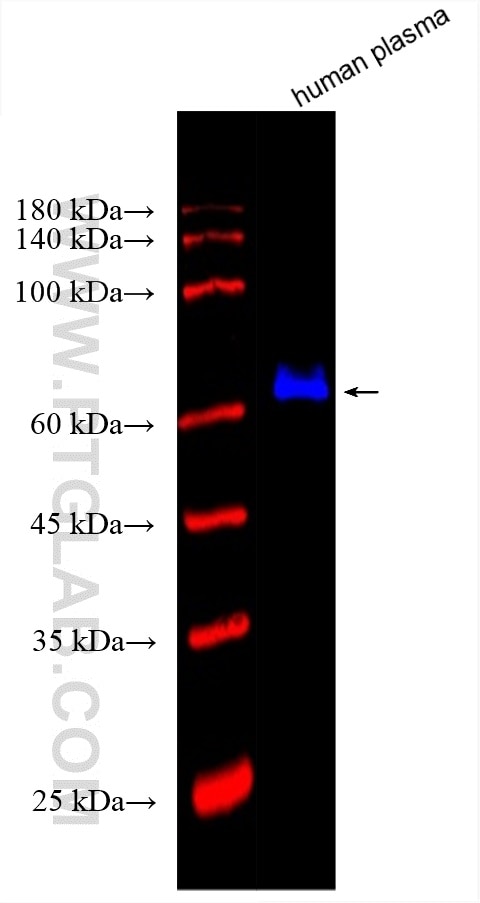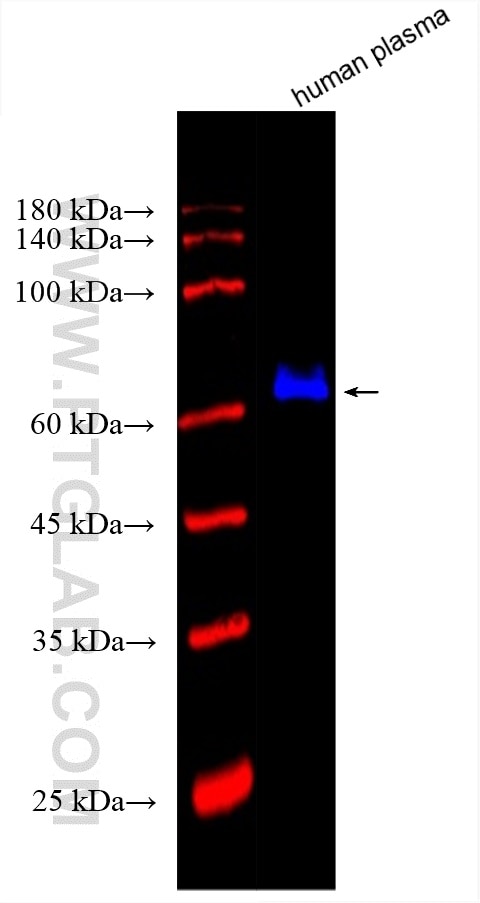Tested Applications
| Positive WB detected in | HepG2 cells, human plasma |
Recommended dilution
| Application | Dilution |
|---|---|
| Western Blot (WB) | WB : 1:1000-1:8000 |
| It is recommended that this reagent should be titrated in each testing system to obtain optimal results. | |
| Sample-dependent, Check data in validation data gallery. | |
Product Information
CL750-66051 targets Albumin in WB applications and shows reactivity with human, rat, pig samples.
| Tested Reactivity | human, rat, pig |
| Host / Isotype | Mouse / IgG1 |
| Class | Monoclonal |
| Type | Antibody |
| Immunogen |
CatNo: Ag9885 Product name: Recombinant human Albumin protein Source: e coli.-derived, PET28a Tag: 6*His Domain: 256-609 aa of BC034023 Sequence: SKLVTDLTKVHTECCHGDLLECADDRADLAKYICENQDSISSKLKECCEKPLLEKSHCIAEVENDEMPADLPSLAADFVESKDVCKNYAEAKDVFLGMFLYEYARRHPDYSVVLLLRLAKTYETTLEKCCAAADPHECYAKVFDEFKPLVEEPQNLIKQNCELFEQLGEYKFQNALLVRYTKKVPQVSTPTLVEVSRNLGKVGSKCCKHPEAKRMPCAEDYLSVVLNQLCVLHEKTPVSDRVTKCCTESLVNRRPCFSALEVDETYVPKEFNAETFTFHADICTLSEKERQIKKQTALVELVKHKPKATKEQLKAVMDDFAAFVEKCCKADDKETCFAEEGKKLVAASQAALGL Predict reactive species |
| Full Name | albumin |
| Calculated Molecular Weight | 609 aa, 69 kDa |
| Observed Molecular Weight | 66 kDa |
| GenBank Accession Number | BC034023 |
| Gene Symbol | Albumin |
| Gene ID (NCBI) | 213 |
| RRID | AB_3084887 |
| Conjugate | CoraLite® Plus 750 Fluorescent Dye |
| Excitation/Emission Maxima Wavelengths | 755 nm / 780 nm |
| Form | Liquid |
| Purification Method | Protein G purification |
| UNIPROT ID | P02768 |
| Storage Buffer | PBS with 50% glycerol, 0.05% Proclin300, 0.5% BSA, pH 7.3. |
| Storage Conditions | Store at -20°C. Avoid exposure to light. Stable for one year after shipment. Aliquoting is unnecessary for -20oC storage. |
Background Information
Albumin is the most abundant protein in blood plasma. Alterations of level of serum albumin are linked to variety of diseases. Albumin is expressed exclusively by well-differentiated hepatocytes, thus anti-albumin has been used to mark hepatocytes. (21388516, 23832071) In additon, glycated serum albumin is also a potential diabetes biomarker.
Protocols
| Product Specific Protocols | |
|---|---|
| WB protocol for CL Plus 750 Albumin antibody CL750-66051 | Download protocol |
| Standard Protocols | |
|---|---|
| Click here to view our Standard Protocols |






